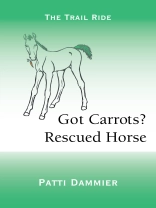Spring was everywhere. The long, dreary, snowy days were fading, and the thawing weather had begun. No longer did the horses have to dig under the snow for grazing. At the edge of small wooded area where the wild horses often took shelter, the heavy branches of the trees, loaded with snow and ice, dripped a steady flow of water. This water would provide moisture for the new growing grass and provide the lush fields for the herd. It had been a long winter, and the horses greeted the kinder weather with anticipation.
It seemed as if it was a wonderful dream as time flew by. There were several more days of classes and then a planned schooling show for halter and trail ride event. The other farms they had visited were going to join the Rolling Hills Farm for a picnic and event day. Got Carrots was going to perform in her first halter class.
There were quiet murmurs among the group, because no one wanted to surprise or frighten the wild horses. Mike whispered, Its them. Look! Its the wild horses.
They all watched in surprised amazement as the herd quietly lined the lake and began to drink. The group watched as the horses slowly drank from the lake. The drinking went on for some time, and just as suddenly as the horses appeared, they departed. It was an unhurried, slow motion as the wild horses vanished into the fading light just as suddenly as they appeared.
Om författaren
Patti Dammierhas been an educator of horses and riders for over 30 years. Her experience both in Europe and the United States provides a broad equestrian perspective. During 23 years overseas, while an elementary school teacher, she studied equestrian disciplines in Spain, Portugal, England, and Germany. Many of the story situations in this book are based on her true-life experiences.
With a Ph D in psychology, Patti is an expert in educational curriculum, psychology, and applied behavior analysis. Based of her background, Patti uses her expertise to write about training horses based on scientific theories and educational methods. Besides working with her own European horses, she continues to help retrain rescued horses. She would like to promote the training of horses through sound educational principles.
Dr. Dammier has two books that support: “A positive method for training horses”. The non-fiction books are about horse training: “Behavior Modification for Horses” and “Horse Makeovers”. She believes that horse-training literature should encourage the equestrian toward that goal. Patti would like to promote the use of valuable educational and scientific information to be applied to both fiction and non-fiction writing for the education of both horse and rider. There are also three fun filled books in the series: “Got Carrots? Rescued Horse”, with interesting stories about horses.












